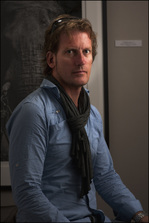<-scroll left or right for more images ->
Christopher Rimmer
Photographer
Christopher Rimmer was born in England an emigrated to South Africa as a child. He began taking photographs as a teenager with a plastic 35mm Hanimex camera and sold his first photograph to the South African angling magazine Tight Lines as a fifteen year old in 1980. After immigrating to Australia in 1981, Rimmer did an arts degree majoring in photography at Rusden College under Paul Green where he gained experience in the use of large and medium format film cameras.
His photographs have been published in many Australian and international publications. He has exhibited in group and solo shows both in Australia and in the United Kingdom, France and the United States. He is represented in several public and many private collections. He obtained an Excellence accreditation in the Federation International de l'Art photographique in 2009 and platinum in 2010. He is a member of the Royal Photographic Society and was recently shortlisted for British magazine B&W Photographer of the Year. Rimmer's work made international news in October, 2010 when Facebook banned his images of breast feeding African women from the site on the grounds that they were unfit to be viewed by minors.
Christopher Rimmer - In Africa opened in Melbourne, Australia in March, 2011 and was a critical success and one of the highest grossing photographic exhibitions of the year. His second Australian exhibition, Spirits Speak opened at Without Pier Gallery in Melbourne in June, 2012 and was also a critical and commercial success. Most recently along with Art Wolfe and Cathy Bernot, he was invited to participate in the Fifty Photographers in Madagascar Project held each year by de l'association les photographes de l'espoir in France.
Now based in Melbourne, Christopher Rimmer traversed the length and breadth of his former homeland and returns for two exhibitions with a stunning body of work comprising 30 detailed photographic works that intimately depict majestic wildlife and proud indigenous peoples. He invites viewers to consider Africa in its full potency and how it’s been perceived with romanticised nostalgia, as well as the real potential of species extinction and endangered ways of indigenous life.
The starkly beautiful landscape, the pride of the cattle herding Himba, Herero and Zimba people, and the stunning and diverse wildlife – lions, elephants, giraffes and zebras - are brought to life in Rimmer’s striking, large scale, monochrome prints. They provide an intimate insight into southern Africa's soul and demonstrate why he was recently short-listed for British magazine B&W Photographer of the Year.
The exhibitions are visual documentation of the world Rimmer experienced in the African bush during his return to his former homeland following his recovery from cancer in 2009. Just five weeks after completing a course of chemotherapy during which he shed 25 kilograms, he rented a Land Rover Defender in Windhoek, Namibia and headed out alone into the vast south-west African wilderness in an attempt to recover his shattered spirit.
During his recovery, Rimmer found himself longing for the landscapes that he drew strength from as a child, even though parts of Africa were under Apartheid rule.
“In returning to Africa I wanted to reconnect with an earlier version of myself and to re-visit the landscapes of my childhood, whose memories gave me strength during some dark days following my diagnosis,” he says.
“When I was a child I felt deeply connected to Africa and I realised as a very sick adult that I needed to feel that connection once again. I now express that re-connection through my photography.”
Driving north into the arid region which forms the border region of Namibia and Angola, Rimmer encountered the semi-nomadic cattle herders, the Himba. The exquisitely featured, bare breasted women of this fascinating tribe dominate Rimmer's portraiture. They recently attracted world attention when Facebook shut down his page depicting them.
“I don't deliberately attempt to place these people in the past,” says Rimmer, “But there is a sense of nostalgia in the way I have constructed the portraits of them and this relates more to my own sense of time rapidly passing and to the piece of myself I left in Africa following my departure in 1981."
“I have included some of the modern elements that are beginning to appear in their lives. In one portrait for instance, a Himba headman carries an MP3 player and wears a combination of traditional and modern clothing, yet he appears more connected to the past than the future.”
“When I photograph wildlife, I attempt to convey the sentient nature of the subject, their emotions being worthy of our consideration and thus emphasising the precarious circumstances of their existence,” he adds.
“Being fortunate enough to see this kind of natural beauty stimulates a strong desire to try to protect it from threats which are all too apparent on the ground over there.
“I fear that my children may not experience this wilderness unless some new method is found to protect it because what has been tried previously is failing,” he adds.
“I aim to stimulate a similar desire in the viewer through creating an emotional connection. When we are emotionally connected, we care, which is why my portrait of the Lowveld Lion looks directly at you almost asking you why he cannot continue to exist.”
In the vast and silent African landscapes where elephants roam and the Himba gather, the rich life and transformative power of Africa is captured by Christopher Rimmer in his work - the same power that restored him.
Christopher


